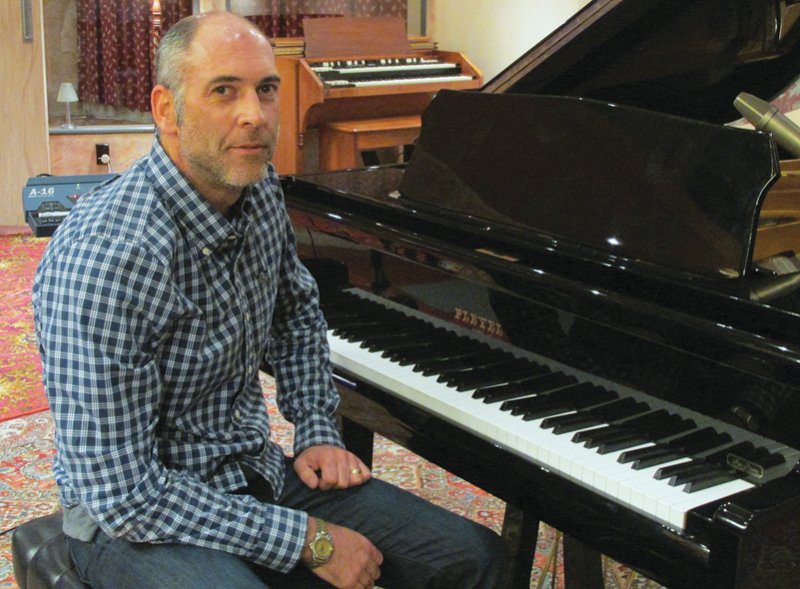York Street Studios: Is Now Closed
York Street Studios: Is Now Closed
In 2013 Parnell’s famed York Street Recording Studios passed the considerable business milestone of turning 21. It did so without party or fanfare, largely because, with the building in the process of being sold, there was little cause for celebration. The sale has been drawn out and uncertain, but at the beginning of NZ Music Month this year the country’s best known studio was formally closed – again without fanfare – although the country’s best-loved rock act were later to deliver the very fitting coup de grace of a filmed live performance of their latest York Street-produced album. Shihad were one of the very first and one of the very last acts to record there, as Jeremy McPike, the studio’s long-time manager, tells Richard Thorne.
“I honestly believe we have sold five million records out of here,” says Jeremy McPike, the now former studio manager of Auckland’s legendary York Street Recording Studios. “Do the numbers, it adds up real quick; Brooke Fraser – 75,000, Goldenhorse – 75,000, 150,000 – Supergroove, 150,000 – The Feelers’ first record… And then there’s all the ones that have sold 10 or 20,000.”
It’s late morning, May 8, 2014, officially York Street’s final week. McPike has occupied this spacious office, overlooking the main recording room – and overseeing the studio’s operation – since the turn of the century. A few days after we talk he will be locking the studio door and walking away for the last time, the studio closing and the building scheduled to be part-demolished and become a high end residential complex. After 14 years in the role it’s surely an emotional time, but McPike has been facing this eventuality for over a year, and is ready to put the drawn out anxiety behind him.
“I’m so stressed out about it closing, and so sad about it. Now I wish I had enjoyed it more at the time, but I’ve always been a stress-head,” he laughs.
Since the beginning of March this year McPike has owned the business himself, the studio’s valued brand plus the much-admired Neve desk, equipment and fittings which have helped make York Street the nation’s best known recording studio, pretty much since its inception in 1992. The equipment is headed for storage, and in a week or so he will be starting work at Neil Finn’s Roundhead Studio, just a few suburbs to the west. Any sadness is balanced in-part with anticipation of that new role.
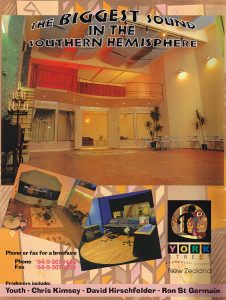 The history of York St has been well captured by Gareth Shute in a very thorough article on the audioculture website. Briefly, it was established and built in 1992 by Kiwis Malcolm Welsford and Martin Williams, along with Killing Joke frontman Jaz Coleman, who added some initial capital (enough to secure the studio’s famed vintage Neve desk) and an international kudos.
The history of York St has been well captured by Gareth Shute in a very thorough article on the audioculture website. Briefly, it was established and built in 1992 by Kiwis Malcolm Welsford and Martin Williams, along with Killing Joke frontman Jaz Coleman, who added some initial capital (enough to secure the studio’s famed vintage Neve desk) and an international kudos.
Well regarded as a rock engineer, Williams had previously run Last Laugh Studio, a hundred stairs above Vulcan Lane, while Welsford had developed his engineer/producer skills at Marmalade in Wellington. He estimates that the studio was built for under $75,000, but says it’s difficult to say exactly, since most people either worked for a pittance or for contra.
“Almost all professional studios were going into audio post production for film and television, and if York Street wasn’t built I would have been faced with a real problem. The studio was able to be built because I had over a year’s worth of advance bookings, another reason to build a professional studio dedicated to music only. Carter Holt allowed me to put $35,000 worth of building materials on account, which was paid back over 12 months.”
In that era Auckland was served by a selection of professional studios, including the nearby Mandrill, Airforce, Revolver, Stebbing Recording Centre and Radio NZ’s Helen Young Studio, but this was a rock environment on the scale of a small mountain. An impressive 280sq m, with a massive high-studded recording room (90sq m) plus mezzanine, three isolation booths, spacious control room, band lounge and kitchen areas, the new studio occupied one corner of the huge former car assembly building.
The results achieved by Welsford and Williams, via their 24-channel 1974 Neve mixing console (first used at Abbey Rd, then EMI in Wellington), propelled the studio into top place on the local studio pecking order. The studio also catalysed a new stage in Coleman’s career and after three or four years he was no longer involved. As successful as it may have seemed, Welsford says that was more the result of very long hours and hard work.
“I guess at that time I was very shy and never revealed that it was me that made the whole thing happen from beginning to end.
He recalls it as always being a financial challenge for them, describing the studio as “…like digging a big pit and pouring cash into it.”
From his perspective, McPike sees the earliest days of York Street as the best time in NZ music (recording) history.
“Things were absolutely going off. The Feelers, Che Fu with Chains, Stellar ‘Mix’ – it was all go for NZ music and this was the best studio in NZ, by far, and Malcolm was one of the best engineers in the country by far, but they messed it up.”
By 1999 the partnership was insolvent, both the personal relationships and financially. The subsequent split was incredibly acrimonious, and bitterness lingers still. McPike blames bad business practices, for instance in opening too many branches, including a second studio in the Shortland St building now occupied by Auckland University’s School of Music.
“York St Mastering, York St B, York St interactive… There were seven phone lines in here. They were fighting, everything was leased, people were smoking in the studio – it was just a mess. They were running it from 1993 to 1999, so six or seven years, and they went broke. We’ve been running it for 14 years and I think we have done a better job.”
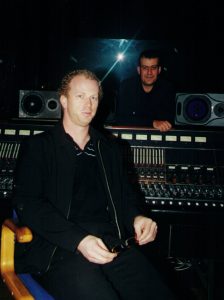 The ‘we’ is Adrien de Croy, classical violinist and bass player, software developer and musical philanthropist, who in the 1990s made a multiple Ferrari-sized fortune from an internet switching package he invented. de Croy has owned York Street for most of that time and also put his money into Siren Records, which delivered brilliant albums from Goldenhorse and early Opshop, among others.
The ‘we’ is Adrien de Croy, classical violinist and bass player, software developer and musical philanthropist, who in the 1990s made a multiple Ferrari-sized fortune from an internet switching package he invented. de Croy has owned York Street for most of that time and also put his money into Siren Records, which delivered brilliant albums from Goldenhorse and early Opshop, among others.
A mutual friend first introduced the pair when McPike was working as a lecturer at SAE in Parnell, and de Croy was planning to build a big new home in Ponsonby, with an elaborate recording studio in the basement.
“So we met and I told him it was nuts, it didn’t make sense. I think he appreciated the candour and we ended up being quite good mates.”
McPike instead suggested that they combine resources, buy some recording equipment (“…some ADATs, an O2R, a pair of U87s and some Genelecs”) and find a space to rent.
“We started looking for spaces and I went into York St B at Shortland St, and talked to Martin to ask if they had any space to rent. He said that actually they were bankrupt and were closing both studios.”
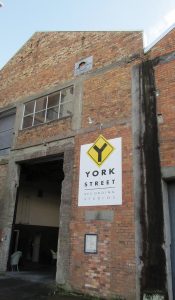 In fact the old Ford assembly site had already been sold to a developer. de Croy subsequently bought the studio business off Williams and Welsford (though the latter says he never received any of the proceeds), then negotiated to purchase the 1900 sq m building.
In fact the old Ford assembly site had already been sold to a developer. de Croy subsequently bought the studio business off Williams and Welsford (though the latter says he never received any of the proceeds), then negotiated to purchase the 1900 sq m building.
“With the benefit of hindsight he paid a lot more than either was worth – but then it was also a really good move, because he basically land-banked in a very fine suburb, with a view of the water. It was never actually put on the market but Adrien has had offers every year. I’ve sometimes wondered if he has hung onto it for no other reason than to keep the studio here,” McPike acknowledges.
“We’ve done okay in what is a challenging business. I run a very lean ship – probably the most extravagant thing we’ve got is the coffee machine – so we haven’t cost Adrien a lot of money. We have been paying our rent and been a really good tenant for the last 10 years. We cost him his initial investment I guess, which really was a donation to the NZ music business, because he never got that money back!”
Backing York Street is far from the only ‘donation’ that de Croy has made over the years to benefit NZ music. His de Croy Arts Trust operated for six years, providing over three quarters of a million dollars of support, before it was wound up in 2004. A full-time administrator worked mainly with the Auckland Youth Orchestra and the St Matthew’s Chamber Orchestra. The trust also made sponsorships to a number of events, such as funding tickets for school pupils.
“The main sponsorship,” de Croy relates, “was the Chamber Music NZ School Chamber Music Competition, which is a hugely important annual event, involving thousands of participants in hundreds of groups across the country. For that competition I also introduced a schools’ prize, in an effort to raise the profile of music in schools. In the final year of operation of the Arts Trust we raised some funds from some community boards around the country, and the rest of the sponsorships for that year were funded out of debt to keep commitments. 2004/2005 was a tough 12 months.”
de Croy’s software business, which also has its offices at 28 York St., has been struggling since before the global financial crisis. He says the sale process actually started back in 2012, when an approach from a developer resulted in a signed S&P contract. That didn’t proceed, but was followed by a contract with another party who intended to keep the studio going.
“That deal finally fizzled out after probably more than a year, then mid-last year the current deal was signed. The site plans didn’t really leave any commercially sensible options to keep the studio going, and also, in May my son had been diagnosed with Type 1 diabetes. After having worked ridiculous hours over the previous 10 years or so, and having now four kids, and not getting ahead financially (in fact struggling to pay staff, and digging a decent-sized financial hole), I decided enough was enough. The building had to go so I and my family could have a life.”
McPike is adamant that York St has been trading positively, but with the building under contract to sell it had to relocate to continue.
“Adrien could no longer afford to subsidise the NZ music business. If anyone could have made York St work in another location it was me, but I couldn’t afford to take that risk on. I needed some help – corporate help, or philanthropist help, or government help. The problem is, if I was to fit out a new lease I would have to borrow more money (on top of the money I borrowed to purchase the York Street equipment) to do that, and would still need to be able to cover the relocation costs, pay rental and pay myself, any staff and the running costs.”
Over the last year he looked at other buildings and worked on various plans, saying he did the numbers a thousand times, but couldn’t make them work.
“I did decide to buy the name and all the gear because, who knows, I might decide to sell my home and build a studio on a lifestyle block one day!”
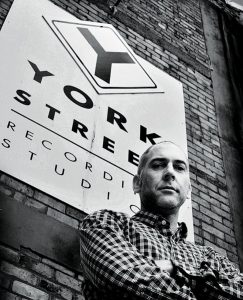 Late last year Neil Finn quite unexpectedly offered McPike a new role as manager of his Newton studio complex.
Late last year Neil Finn quite unexpectedly offered McPike a new role as manager of his Newton studio complex.
“It’s kind of serendipity that I went to Roundhead to look at Studio B, and talk to Neil about maybe leasing it and relocating my gear there, and he said, ‘Oh, that could work.’ On thinking about it more, he said, ‘Why not just come and run Roundhead? It’s easier, it’s simpler and less confusing.’
Neil Finn says that, “…like most of the musicians in NZ,” he has had great recording experiences at York Street.
“It’s sad to see it go, but half the reason we all liked it so much has been the good management and positive energy of Jeremy McPike over there. Jeremy understands what it takes to maintain a good creative space for making music and we feel lucky to have his presence now at Roundhead.”
McPike describes the last 14 years of York Street business as up and down, and up and down.
“When we first started the place was desolate, it took me two years to get it back up to speed. About the time the Goodshirt album came out everybody was doing things in their own garage, using their five grand [NZ On Air grants] to buy a ProTools rig, and it was all in a bit of disarray. We ended up ‘fixing’ more than mixing. People were screwing it up at home and record companies were coming to us to fix it. So I quickly realised that if we could make our ProTools system compatible with 001 systems and stuff then we could add value to those projects, and it worked very well.”
He says York Street has been 95% full over the last few years. If there was a peak of busy-ness, it was around 2004/5 – when the Revolver Studio complex at Pah Rd and Radio NZ’s Helen Young studio both closed – and before Roundhead Studios opened in 2008. Of all the local professional studios, past and present, Roundhead is most similar to the York St model, including having its own 40-channel Neve desk.
“When Roundhead opened everybody was saying that I must be so pissed off, but I wasn’t. Of course it was competition, but I welcomed it and was pleased to see the business growing rather than shrinking for a change. I don’t think anyone understood that we were very much alone in trying to be the pinnacle of high quality recording – high quality gear, high quality everything – and now I had someone else to talk with.
“I was completely alone. If my equipment broke I was fucked. If I had a technical question I had no one to ask. Now I had Neil Baldock creating this other beautiful studio, and finally we were able to talk the same language and discuss the same kind of issues. I was invited up during construction and I was excited by it.”
Big studio day rates are ridiculously low globally, says McPike, and had York Street been in any other major city it would likely have closed sooner.
“Pretty much the only big studios that are still there are owner operated, or old studios that have a really good rent deal. There would be very few people who own commercial studios that are glad they own them at the moment. Basically the day rate at York St [$1500] has stayed the same, from the day it opened until the day it closed, so if you take into account inflation, and the cost of everything, we probably charge half of what we should be charging.”
Welsford recalls The Feelers’ ‘Supersystem’ album, which he engineered, produced, and mixed with the band, as being the longest local act booking, saying that back then three weeks was considered a long booking. With big album projects increasingly rare, predominant these days are two- or three-day bookings, and single day tracking sessions. Shihad had York St for two weeks in December last year for their fourth York St-recorded album, which – fittingly – Jaz Coleman again produced.
“It’s really good when you get an album in,” McPike agrees. “But there is a cost to long projects, which is that other people can’t get in – so they go somewhere else instead. Everybody thought they’d get a discount if they did an album, but I did it the other way round. Two or three days were cheaper, but when it came to booking it out for weeks it went back to full day rates.”
York Street has been used for all sorts of other things than artist recordings. Product shoots, TVCs, music videos, trade functions, Flying Nun’s 21st birthday celebration and numerous launch functions. It’s been popular for live radio/TV and internet recordings – Channel Z’s Coleman Sessions back in early 2000s and more recently the NZ Herald Sundae Sessions, which scored a coup in filming Shihad performing their yet-to-be-released album live there – after the studio officially closed.
“I’m not even a musician, but I see the looks on the bands’ faces when they walk in the room, or in the control room after soundcheck,” says Hugh Sundae. “Visually it’s such a great room to shoot in, the high stud, mezzanine floor, stairs are all more than you get most places. But the main aspect for us is the depth you get from it being such a large square room – shooting past the crown, the band, the drums, back to one of those lampshades that’s been featured in countless videos. Seeing it out with Shihad? Pulling that together is probably the highlight of my career.”
Recording of the Rugby World Cup opening ceremony music, with the APO and Victoria Kelly, is one highlight McPike cites.
“I think the magic of York St is a combination of a generally friendly vibe – and I know I’m not talking about the sound – I’m talking about how they feel when they’re here. It starts with the musicians feeling welcome, and that everybody is here to help. We help them load their gear in and set it up, and within half an hour the drums are set up and ready to rock’n’roll.
“Once that barrier is down there’s no negativity in the room, no nervousness or anxiety. Then you’ve usually got musicians who have practised a lot, with great instruments and then a great sounding room, with a nice set of microphones and a really fantastic console. I think the magic is all of those things put together and mixed around – and steeped in history.”
And history there is. Among the world famous artists and bands that have recorded in the Parnell studio are Crowded House, Killing Joke (of course), Garbage, Interpol, The Beastie Boys and The Black Eyed Peas. And Shihad.
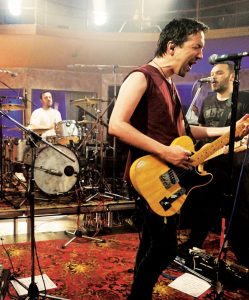 Big albums typically involve big tensions and Shihad have plenty of York Street tales, good and bad, from the four they have done there. Performing there live, Jon Toogood was clearly proud his band got to bookend things for the studio saying that they “…were kind of born here.
Big albums typically involve big tensions and Shihad have plenty of York Street tales, good and bad, from the four they have done there. Performing there live, Jon Toogood was clearly proud his band got to bookend things for the studio saying that they “…were kind of born here.
“[York Street] was pretty much responsible for us learning to be a rock’n’roll band – and cos it’s so kickarse, letting us dream that we could be one of the biggest.
He told the crowd he’d written Home Again in the office and in typically direct Toogood fashion said it was “… fucking criminal this place is closing”.
Drummer Tom Larkin explains how global politics and a sense of history drew things together, meaning Shihad once again recorded an album there with Jaz Coleman, so providing a ‘perfect’ closure.
“It had turbulence in trying to get it to fit, and it was a mix of determination and magic the way it all fell into place. We had been due to go to Spain or Egypt, or a combination of both, to record the album. When we couldn’t do the Egypt dates, after the whole place exploded politically, Jaz abandoned the project, saying he didn’t want to do it anymore.
“We talked about where to do it and booked some tentative dates at York Street. Then we heard it was closing, and as soon as I heard that I called our manager and said, ‘We may be the last album recorded there. Now you’ve got a story, you gotta call Jaz.’ And Jaz got it. To be the first in and last out, there was some magic to that. And he did such a great job, we had a great time with him here, it was fantastic.”
McPike laughs about the legendary ‘York Street drum sound’ that Larkin helped enshrine, as much a blessing perhaps as a curse. While the studio has regularly been used by bands for drums-only sessions, there’s only recently been a resurgence of interest in that big drum sound. Much more commonly they’ve used the smaller rooms, or built booths around the drums, for the close-mic sounds of pop music or hip hop.
“I used to get that York St ‘only had one drum sound’. That came from when Martin and Malcolm finished here, and it’s complete and utter nonsense. You only have to listen to a Pluto album, and then a Mercenaries’ album, and then a Nathan Haines’ album, then a Feelers’ record, or one of about three million reggae records that don’t sound anything like that!
“It could be a massive sounding John Bonham room, or it could be a really tight hip hop sound, or anything in between. What the space did have is volume. The height [a whopping 6m] of the room really let the sound expand, which adds bass to everything. A kick drum sound could fully develop and so the drum sound is fuller than you could get anywhere else. Drums being hit by a monster player really sing in there because there’s so much space.”
Now a well-known producer and studio owner himself, Shihad’s Tom Larkin well remembers his York Street experiences.
“Although ‘Churn’ had a tone to it that was unique (and I think both Jaz and the studio each had a big part in that), in terms of drums and York Street, I was really pleased with how ‘Killjoy’ [1995] came out. And I think that was a combination of things. Before that I was using modern drums and I changed to a much more vintage style of Gretsch, with a 26 kick – and using jazz skins – basically like a big jazz kit.
“And I think that Malcolm was really hitting his stride with the studio and the console – and he basically murdered it to tape! The amount of level he used. Knowing how this console works, you actually have to drive it further than you think is ‘correct’, to make it kind of bend into a tone. It’s like driving an amp. So he did that with ‘Killjoy’, and between the drums and the desk and engineer and the room itself, ‘Killjoy’ was the one.”
After two decades the list of producers includes numerous other international luminaries like Mitchell Froom, Gil Norton, Youth, Malcolm Foster, Tchad Blake along with most of Aotearoa’s finest.
“The first records I did there were Fightback for 48 May and Disconnect for Ejector (with a young Nik Brinkman from Over the Atlantic/Junica), recalls now Auckland-based Welsh producer Greg Haver, who has since used York Street for acts including Manic Street Preachers, The Fight, Patrick Jones, GEM and Drive by Audio (for Grand Theft Auto 4).
“This was when I was brought over by the British Council in February 2003 for the Resonate seminar. I was blown away by the studio. I was a little apprehensive as I had been doing all my work on SSL E and G+ consoles, so the sound of the Neve, the room and how well trained up the staff were just floored me, and really made me re-think the way I was making records. It also made me realise that Starbucks was rubbish and started my long addiction to great coffee!
“I was back in August that year to produce The Feelers’ ‘Playground Battle’ album, which went triple platinum and really gave me an extended relationship with NZ music. I have seen many wonderful studios close over the years and you always leave a part of your musical soul there, but I feel that York Street is the saddest loss of all as it has been a huge part of my life, my love of NZ music and NZ itself.”
York Street can rightly claim to have schooled some of our leading young recording engineers, something not lost on Haver, who subsequently snared Clint Murphy to work alongside him at Modern World Studios in the UK. He says Murphy has developed a “world-class reputation” as a mix engineer.
“Jeremy trains all his staff so well that I have done records with many of them and have also brought guys like Nick Poortman, Si Gooding and Cam Duncan over to the UK to work on sessions. Nick was our assistant at Modern World Studios for several years and is my main engineer here now I am a resident.”
McPike says the international producers like Haver have added much, including a certain pride.
“What we get as feedback from outsiders is about the attention to detail of NZ sessions. They are tidy, they’re edited well, they’re faded well, the critical listening is happening. Most international producers are impressed by what we are doing here. The sound quality that comes from NZ studios is of a very high calibre. The sound quality from home-based studios is much more mixed, but in general NZ engineers bust their arses to make stuff sound fantastic.”
Other bright York Street ‘graduates’ include, Andrew Buckton and Nick Abbott, Steve Roberts, Hayden Taylor, Hook and Justin Maudsley. Currently working in the Cotswolds, England, Clint Murphy reflects the engineers’ shared sadness.
“It really guts me that York Street is gone. When I studied at SAE I dreamed of one day working there, and then Jeremy made that dream come true. It was at York Street where I touched my first 1176, my first Neve channel, my first TG Limiter. That room, wow, what a sound. Every time I recorded there it made me smile so widely, it was just so easy to get a killer sound. It’s hands down my favourite drum room, and now it’s no longer there I feel like I’ve lost a best friend.”
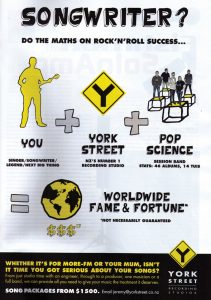 It was McPike who came up with the idea of providing a house band, and in 2009 York Street started promoting Pop Science, a flexible bunch of seasoned session musicians available to help any clients out
It was McPike who came up with the idea of providing a house band, and in 2009 York Street started promoting Pop Science, a flexible bunch of seasoned session musicians available to help any clients out
“I was getting a lot of enquiries from solo artists and I needed to facilitate getting either their music programmed, or put together another way. It ended up being one of the life-savers of York Street really.”
Members have included drummer Scotty Pearson on drums, guitarists Simon Moore and Tom Healy, Clint Harris on bass, and Stephen Small, who has been the MD lynch pin, on keyboards. He says the band will “absolutely be carried through to Roundhead.
“They are extraordinary, so clever, and the coolest guys – none of them get paid anything like what they’re worth. I always thought that everything they did would come out the same, but every single thing they’ve done is different.
“The other clients that have helped us over the years are the bands of mates who are 50 years old. One’s a plumber, one’s a doctor, one’s a lawyer and so on, and they have the money to try and see how good they can sound. For them it’s like, ‘Why not? It’s only $1500 a day!’ I’d take those projects from an email through to a finished single, EP or album, with a very happy customer, and that’s very satisfying.
“I’m not a producer, or some sort of music magician. I’m a host. I run a business, not dissimilar to a café or restaurant where customers come in, get looked after and come back. We make sure that our equipment is working and we provide the right environment. Attention to detail and attention to customer service, I never took it for granted, always made sure every customer was looked after, so I was always on edge, but I feel now I could have relaxed and enjoyed it a bit more! But hey, what are you going to do?
“It depends on your definition of the role, but I have actually executive produced a ton of records, just never got a credit. Say for example Jamie McDell’s album. EMI really didn’t know what to do with her and I said I’d do four demos with the York Street session band – and one of them went to #1! So they gave me the record, I hired the band, booked the studio time, did the budget, liaised with the record company and so on. And I’ve done that process to so many albums and singles that I can’t really name them, probably a hundred Top 10 singles or albums.”
And so to Roundhead, where the highly regarded Neil Baldock has, until last year, been the lead house engineer and manager. Current York Street employee Scott Seabright will join Jordan Stone and Jason Huss, but McPike says there will be no ‘head’ engineer. It will instead be run with freelance sound engineers and producers.
“Every engineer and producer will be welcome, and the Roundhead engineers will gladly assist them to make the most the incredible facilities. There are three in-house engineers who are very, very talented. The plan is to get these two incredible studios busy making great music everyday.”

